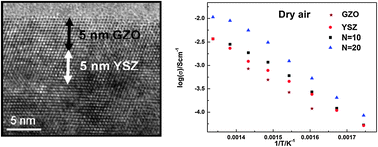Multilayered YSZ/GZO films with greatly enhanced ionic conduction for low temperature solid oxidefuel cells†
Abstract
Strain confinement in heterostructured films significantly affects ionic conductivity of the electrolytes for solid

Maintenance work is planned for Wednesday 1st May 2024 from 9:00am to 11:00am (BST).
During this time, the performance of our website may be affected - searches may run slowly and some pages may be temporarily unavailable. If this happens, please try refreshing your web browser or try waiting two to three minutes before trying again.
We apologise for any inconvenience this might cause and thank you for your patience.
* Corresponding authors
a
Department of Mechanical, Aerospace & Nuclear Engineering, Rensselaer Polytechnic Institute, Troy, New York 12180, USA
E-mail:
lianj@rpi.edu
Fax: +1 518 276 6025
Tel: +1 518 276 6081
b Physical Sciences Laboratory, Pacific Northwest National Laboratory, Richland, USA
c Departments of Earth & Environmental Sciences and Materials Sciences & Engineering, University of Michigan, Ann Arbor, USA
d Environmental Molecular Sciences Laboratory, Pacific Northwest National Laboratory, Richland, USA
Strain confinement in heterostructured films significantly affects ionic conductivity of the electrolytes for solid

 Please wait while we load your content...
Something went wrong. Try again?
Please wait while we load your content...
Something went wrong. Try again?
B. Li, J. Zhang, T. Kaspar, V. Shutthanandan, R. C. Ewing and J. Lian, Phys. Chem. Chem. Phys., 2013, 15, 1296 DOI: 10.1039/C2CP42964K
To request permission to reproduce material from this article, please go to the Copyright Clearance Center request page.
If you are an author contributing to an RSC publication, you do not need to request permission provided correct acknowledgement is given.
If you are the author of this article, you do not need to request permission to reproduce figures and diagrams provided correct acknowledgement is given. If you want to reproduce the whole article in a third-party publication (excluding your thesis/dissertation for which permission is not required) please go to the Copyright Clearance Center request page.
Read more about how to correctly acknowledge RSC content.
 Fetching data from CrossRef.
Fetching data from CrossRef.
This may take some time to load.
Loading related content
